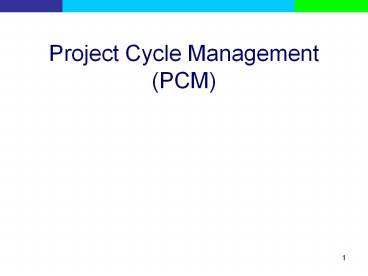Project Cycle Management (PCM) - PowerPoint PPT Presentation
1 / 20
Title:
Project Cycle Management (PCM)
Description:
Project Cycle Management (PCM) Contents of this Presentation Mission What is the Project? What is the Project Cycle Management (PCM)? Why the PCM?, its history ? – PowerPoint PPT presentation
Number of Views:1114
Avg rating:3.0/5.0
Title: Project Cycle Management (PCM)
1
Project Cycle Management (PCM)
2
Contents of this Presentation
- Mission
- What is the Project?
- What is the Project Cycle Management (PCM)?
- Why the PCM?, its history ?
- Project Design Matrix (PDM)
- 8 Steps for PDM in PCM
3
We will get SKILLs to develop a Project Design
Matrix (PDM)by Project Cycle Management (PCM)
approach
Our Mission and Promise in 6 Sessions
4
What is Project?
- Objective
- Activities ? Outputs
- Duration
- Budget(Input)
- Resources (Input)
An Undertaking for the purpose of achieving
established objectives, within a given budget
and time period.
5
What is Project Cycle ?
- Project identification
- Project formation
- Appraisal
- Implementation
- Monitoring
- Plan revision
- Evaluation
- Feedback
6
Project Cycle Management
Plan (Idea)
7
Why Project Cycle Management ?
- Results-oriented not activity driven
- Consistency
- Logically sets objectives and actions
- Participatory stakeholder involvement
- Transparency
- Shows whether objectives have been achieved
Indicators (for ME) - Framework for assessing relevance, feasibility
and sustainability - Describes external factors that influence the
projects success assumptions and risks
8
History of PCM Method
- Late 1960s Logical Framework (USAID)
- ? International Agencies introduce the
Logframe - Early 1980s ZOPP (GTZ)
- Objectives-Oriented Project Planning
- ? European countries adapt the ZOPP
- Early 1990s PCM(FASID/EC)
9
Project Design Matrix(PDM)
10
PDM Vertical Logic
- Overall Goal
- Direction that the project should take next
- Project Purpose
- Objectives that the project should achieve
within the project duration - Outputs
- Strategies for achieving the Project Purpose
- Activities
- Specific actions taken to produce Outputs
- Important Assumptions
- Conditions important for project success, but
that cannot be controlled by the projects.
Whether these conditions develop or not is
uncertain.
11
PDM Horizontal Logic
- Objectively Verifiable Indicators
- Standards for measuring project achievement.
- Means of Verification
- Data sources from which indicators are derived.
- Inputs
- human resource, materials, equipments,
facilities and funds required by the project. - Preconditions
- Conditions that must be fulfilled before a
project gets underway
12
8 Steps for PDM in PCM
- Stakeholder Analysis
- SWOT Analysis
- Problem Analysis
- Objective Analysis
- Project Selection
- Project Design Matrix (PDM)
- Workplan
- Monitoring and Evaluation
13
STEP1 Stakeholders Analysis
Stakeholder is any individual, group or
organization, community, with an interest in the
outcome of a programme/project.
Key Question Whose problems or opportunities
are we analyzing? Who will benefit or loose-out,
and how, from a potential project intervention?
14
STEP2 SWOT Analysis
- SWOT analysis is a tool for institutional
appraisal and a brainstorming exercise in which
the representatives of the organization
participate fully. - This is to Assess the performance and capacity of
the units or divisions of a organization
15
STEP3 Problems Analysis
- Problems Analysis visually shows the causes
and effects of existing problems in the project
area, in the form of a Problem Tree. It
clarifies the relationships among the identified
problems.
16
STEP4 Objectives Analysis
- Objective Analysis clarifies the means-ends
relationship between the desirable situation that
would be attained and the solution for attaining
it. This stage also requires an Objective Tree.
17
STEP5 Project Selection
- Project Selection is a process in which
specific project strategies are selected from
among the objectives and means raised in
Objectives Analysis, based upon selection
criteria.
18
STEP6 Formation of the PDM
- The project design Matrix (PDM) is formed
through elaborating the major project components
and plans based on the approach selected. The
format of PDM is similar to that of the Logical
Framework, and therefore can be commonly used
worldwide.
19
STEP7 Workplan / Plan of Operations
- The Plan of Operation is prepared by the
project implementers, based on the PDM and other
information. It is an effective tool for project
implementation and management, and provides
important data for monitoring and evaluation of
the project.
20
STEP 8 Monitoring and Evaluation
WHY DO WE HAVE TO DO THIS?
- Strengthens accountability and transparency
- Provides information for effective management
- Helps determine what works well and what requires
improvement - Builds knowledge



























![[Project Name] Post-Mortem PowerPoint PPT Presentation](https://s3.amazonaws.com/images.powershow.com/7091326.th0.jpg?_=20150827017)



